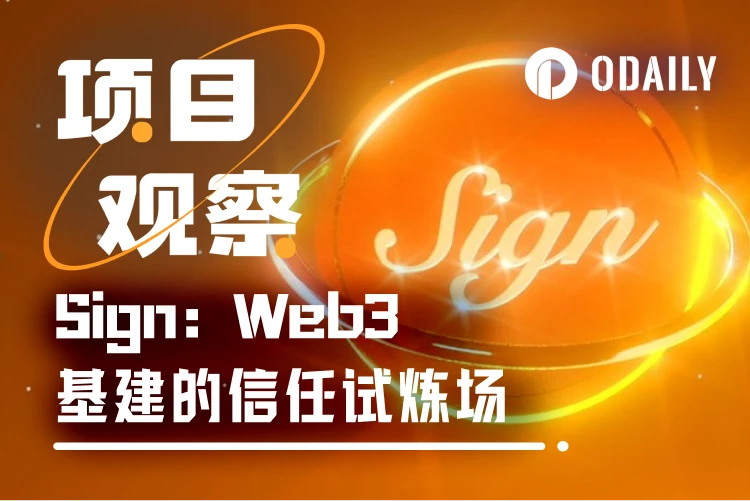Original | Odaily Planet Daily ( @OdailyChina )
Author | Dingdang ( @XiaMiPP )

The ideal of Web3 is decentralized trust, but in reality, trust is often fragile. Sign, a protocol with on-chain identity authentication and token distribution at its core, promises to bring transparency and security to the Web3 ecosystem. However, in early April, its token distribution platform TokenTable caused controversy due to the Wayfinder project ($PROMPT) distribution accident - a protocol designed to build trust, but was exploited by external participants due to social behavior loopholes. This incident pushed Sign to the forefront and became a testing ground for its technology and responsibility.
On April 24, Sign announced that it would take a snapshot soon, and the TGE (token generation event) of its native token SIGN entered the countdown. TokenTable has rebuilt community trust through transparent remediation measures and comprehensive compensation, and Sign is moving towards the forefront of Web3 infrastructure at a more steady pace. From on-chain signing tools to full-chain verification protocols, how does Sign grow amid challenges? Can it reshape the rules in the track of trust?
From EthSign to Sign: The starting point of on-chain trust
The story of Sign began in 2021 with EthSign, an on-chain document signing platform. Through EthSign, users can verify the consistency of documents and complete the signing on the blockchain, providing trusted support for scenarios such as smart contracts and asset ownership. In 2024, the team launched Sign Protocol, expanding its vision to a broader on-chain identity authentication and token distribution infrastructure.
By aggregating on-chain credentials, Sign Protocol provides a transparent and traceable mechanism for scenarios such as token airdrops, DAO governance, and identity authentication. For example, it can ensure the legitimacy of DAO voting or the fairness of airdrop distribution, accurately solving the trust pain points of Web3. As of 2024, Sign has served more than 200 projects such as Movement, Starknet, and ZetaChain, with an annual revenue of US$15 million, demonstrating its commercial potential and wide applicability. Signs goal is to pave the way for Web2 users to enter Web3 and create a standardized trust infrastructure.
Capital endorsement: the cornerstone of industry confidence
Signs ambition has won the favor of top capital. In 2022, EthSign completed a $12 million seed round of financing, led by Sequoia Capital India and Mirana Ventures, with participation from Amber Group, Circle Ventures, HashKey Group and other institutions. In January 2025, Sign received another $16 million in financing led by YZi Labs, with participation from Altos Ventures, HackVC and other institutions.
Binance founder CZ once said in an email that the verification and distribution mechanism is the key to Web3 trust. This evaluation not only highlights the industry value of Sign, but also wins it authoritative endorsement. The new funds will help Sign deepen cooperation with exchanges and government agencies, explore AI-driven verification applications, and promote the construction of the SIGN token ecosystem. The continued support of capital reflects the markets confidence in Sign as Web3 infrastructure.
Products and Challenges: Technology Tempering in Accidents
Signs ecosystem is supported by two pillars: TokenTable, an efficient token distribution platform, and Sign Protocol, a powerful on-chain verification framework. TokenTable has distributed over $2 billion in tokens to nearly 100 projects to meet the complex needs of current airdrops. Airdrops are far from a simple click to claim, they require seamless operations across multiple chains, handling millions of addresses, verifying the composite identity of on-chain wallets and social identities, and meeting compliance requirements such as KYC and OFAC.
To address these challenges, TokenTable has integrated a series of technical solutions. It optimizes gas costs through off-chain computing and on-chain Merkle proofs, uses distributed task pipelines and multi-layer caches to achieve high concurrency processing, and customizes strategies for chains such as EVM, Solana, and TON, such as TONs same-shard transaction optimization. The delegation mechanism allows project parties to pay gas fees on behalf of others, improving user experience. At the same time, multi-layer protection ensures protection against threats such as replay attacks, and compliance functions such as KYC and geographic restrictions further ensure global applicability.
Even so, the Wayfinder ($PROMPT) airdrop on April 10th still encountered setbacks. The accident originated from Twitters identity signature verification system in cooperation with Kaito. An external participant took advantage of predictable social behavior and public rollout mode, combined with MEV (miner extractable value) strategy, to interact with the claim process in advance, causing the system to be suspended. The accident affected 1,781 users, of which 249 people suffered losses due to transaction failures, and 1,532 people were unable to claim due to contract suspension.
Fortunately, TokenTable responded quickly and decisively, and initiated the claims process in a timely manner. Although the Wayfinder incident was a challenge, TokenTable is strengthening its resilience through anti-frontrunning mechanisms, consulting MEV experts, and committing to transparent audit disclosure, turning this incident into a catalyst for improvement.
Sign Protocol represents the core innovation of Sign. It ensures the transparency of token distribution and governance through full-chain credential verification, such as verifying DAO voting identity or airdrop rule execution. Its multi-chain compatibility and high security make it unique in Web3 infrastructure.
SIGN Token: Ignite the Ecosystem’s Engine
The launch of the SIGN token marks a new phase for the Sign ecosystem. With a total supply of 10 billion and an initial circulation of 12%, the token will be minted on the Ethereum mainnet and distributed across chains such as BNB Chain and Base. The distribution plan takes into account both community and long-term development: 40% for community incentives, 20% for early supporters, 10% for the team, 20% held by the foundation, and 10% for ecosystem expansion and charity. This design injects vitality into the ecosystem through community-oriented incentives.
SIGN will be launched on Binance on April 28, covering USDT, USDC, BNB and other trading pairs. TokenTable will be responsible for the airdrop distribution of SIGN, rewarding early community contributors through a mechanism based on SBT (Soul Bound Tokens), with screening criteria including quality of interaction, participation in Orange Dynasty events, content creation and technical contributions. In response to community suggestions, Sign cancelled the airdrop reduction mechanism, increased the frequency and total amount of distribution, and demonstrated its emphasis on users.
Binance Alpha and HODLer plans to further expand airdrop coverage, and tokens will be distributed before trading.
Future and Challenges: The Journey of Trusted Infrastructure
Signs vision is to apply full-chain verification to a wider range of scenarios, such as on-chain digital identity systems or public voting mechanisms, to provide trusted authentication for governments or to design compliant airdrops for DeFi projects. However, the Wayfinder incident revealed the challenges of complex systems in behavioral vulnerabilities. TokenTables charging model (fixed fee + tiered pricing) has also sparked community discussion, and the team plans to increase transparency through public pricing. With the launch of the SIGN token, Sign stands at a new starting point. On the trust track of Web3, can it become the cornerstone connecting Web2 and Web3? The answer to this journey depends on the joint witness of technology, community and time.










